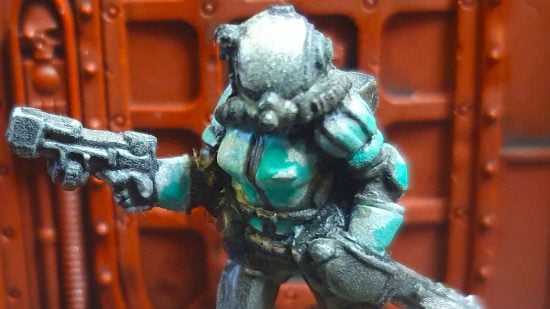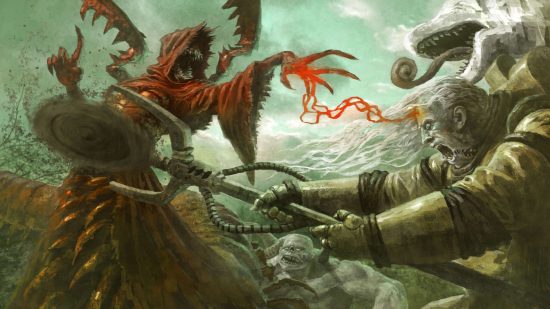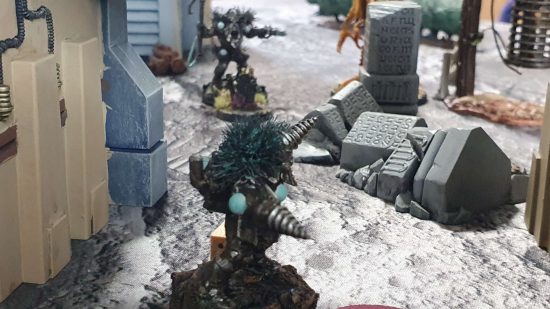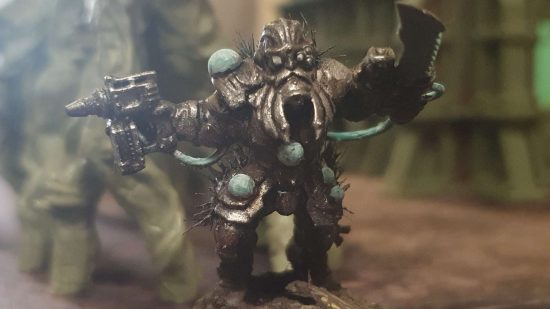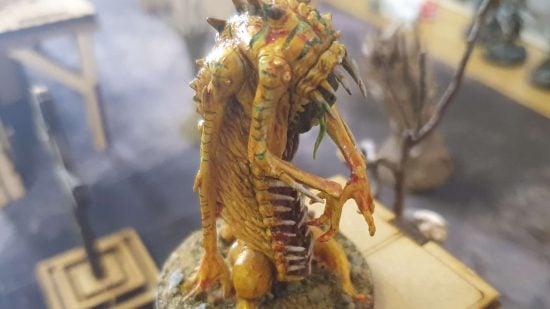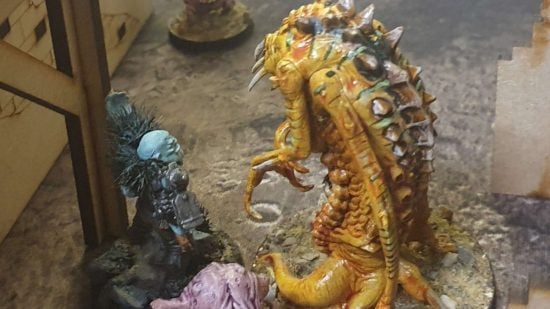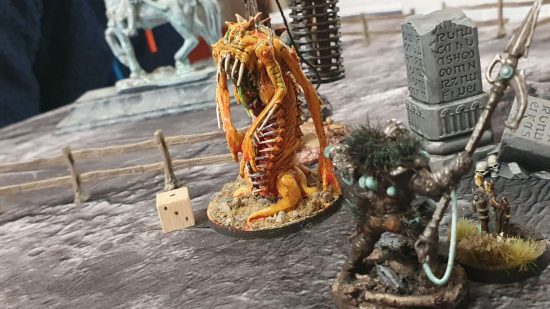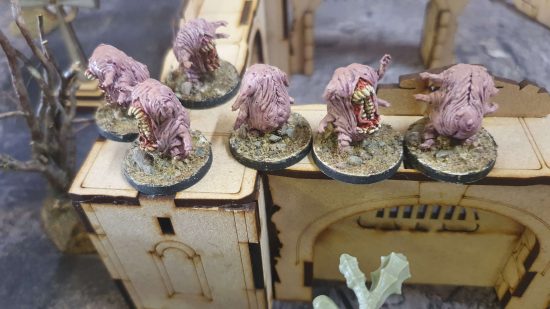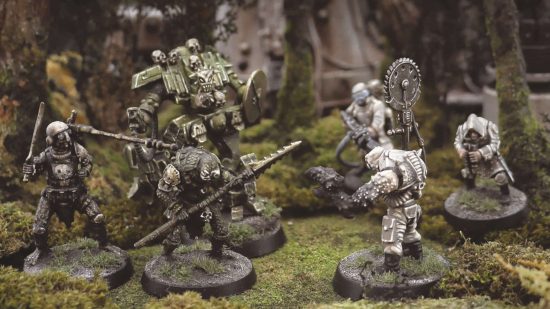The Doomed is a skirmish wargame with lightweight rules and heavy metal everything else. The setting – a sci-fi world abandoned by ‘The Company’ that settled it, now haunted by Horrors from beyond the stars – would fit right at home in the darker corners of the Warhammer 40k universe. Publisher Osprey provided Wargamer with a free review sample of the rules: here’s everything you need to know.
While there’s no ‘28’ in the title, this is definitely a product of the Inq28 gaming scene, an offshoot of Warhammer 40k fandom all about kitbashing and weird indie wargames with a focus on narrative gameplay. The book offers plenty of inspiration to help develop your “kitbash attitude” and create your own converted weirdos, but you’ll also be able to use minis from various Warhammer 40k factions without too much fuss.
The 176-page book is illustrated with art by Helge C. Balzer, himself a GW freelance artist, and with kitbashed miniatures by Ana Polanšćak, a luminary of the Inq28 scene. This art goes hard: this is a mixed up world of techno-daemonic monsters and techno-barbarian mutant hunters, and everything is deadly.
The core rules by Chris McDowall are incredibly light, fitting onto 10 pages. Models have a single stat, Quality, which ranges from 3+ for a leader to 5+ for a basic minion. Models get three actions per turn, and everything but the first move in a turn requires a roll equal to or over Quality to succeed.
There’s no range measurement. Battles take place on small boards about the size of a Kill Team board, with plenty of terrain. A movement is any distance across open ground in a straight line, or vaulting an obstacle, climbing a wall, leaping a small gap. Fail a Quality roll to move and your opponent gets to place you, leaving you out in the open.
With the right terrain, this worked a treat. Creating a battlefield where there was no unbroken line of open ground between opposite board edges just naturally created interesting terrain layouts. There was something about the process of tweaking barricades and buildings to break those lines that seemed to effortlessly produce great arenas.
There’s also scarcely any tracking of data. You’ll mark models as exhausted after they activate, but that’s the only token you’ll put on the board. Models are either healthy, or wounded and knocked over onto their backs.
Weapons have two stats: the number of dice they roll to attack and the number of saves the opponent needs to make for each attack that hit. Again, these are rolls against Quality.
Being wounded triggers a Shock roll which could kill the model outright, or see them scramble into cover, fire back on the nearest model, or other chaotic results. Once downed, another unsaved wound kills the model outright.
These simple stats and brutal combat system might suggest that units feel homogenous, but that’s really not the case. Most units have one or more abilities, either a standard ability that grants them rerolls to certain tests – like Nimble, which grants rerolls to moves and to saves against shooting – or something unique, like better melee attacks against enemies touching an ally, or a free move at the end of their turn.
While the rules are lightweight, scenarios aren’t. You’ll roll or pick from a choice of 36 competitive Conflicts and 36 semi-co-operative Horrors. The Conflict might be a duel to take out the enemy Leader, a scramble to retrieve relics or capture important locations, before the opponent does, and other standard skirmish game stuff.
The Horror, though, is something else. A monster, warmachine, cult, sentient dust storm, echo of sin, zombie horde, or any other unimaginable threat, each Horror has deadly weapons, weird abilities, and can only be killed when its three ‘Nexuses’ are destroyed.
For some Horrors each Nexus is a physical object – the Devourer becomes vulnerable once its food stashes are destroyed – but it could be anything, and it could do anything. The three Warped Hunters each carry a Nexus that is destroyed when that Hunter is first wounded. The Abyssal Colossus’ Nexuses are destroyed as soon as anyone touches them, but they immediately explode in that model’s face.
Horrors, their minions, and any other unaligned models generated by the scenario follow a simple and aggressive AI, with one AI mini activating each time a player finishes their turn. Horrors also react in response to their Nexuses being destroyed, usually evolving into a more horrific form, and every round they survive they’ll perform some other random reaction, usually to your detriment.
In the games I played the tension level was high. Both my opponent and I built warbands that were pretty survivable against low level threats, but lacking in serious firepower. There was little we could do to survive a fully juiced Horror except run the hell away. Games have been bloody.
The level of chaos is high – you could lose your leader to a lucky shot, bad save, and lethal Shock roll on the first turn of the game, a huge blow. I’d call it a beer and pretzels game, but it’s more like maximum carnage bumper cars.
Like any good warband-based miniature wargame there’s a campaign system connecting your missions. It seems to be tailored around two players playing a 1v1 series; both players gain the same amount of Renown (the currency used for warband building) based on how close the Horror was to death. Actually winning a Conflict or killing a Horror grants permanent access to new Rewards to upgrade your warband, but not more resources to buy them.
You’re free to rebuild your warband with different models every mission, the only stipulation being that a mini needs to survive at least one battle before it can be upgraded with Rewards. Models that fall in battle might die permanently – the game suggests you put that model on the bench for at least one game before reusing it – or some other fate, like going MIA, guaranteeing they’re part of the next battle but placed on the board by your opponent.
There’s a couple ways to trigger the end of a campaign, the most likely being that one player reaches 10 Prestige for killing Horrors and winning Conflicts. That’ll lead to one more big Climax scenario, and then it’s a wrap.
In case it’s not obvious, this isn’t a tournament game – it’s an excuse for people who love kitbashing to go absolutely buck wild. Every Horror or Conflict has additional optional rules, AND a solo mode. Then there’s a whole system of creeping Dooms that might trigger an even harder final scenario, modifies how you can build your warband in the next game, sometimes with restrictions, sometimes with cool new options.
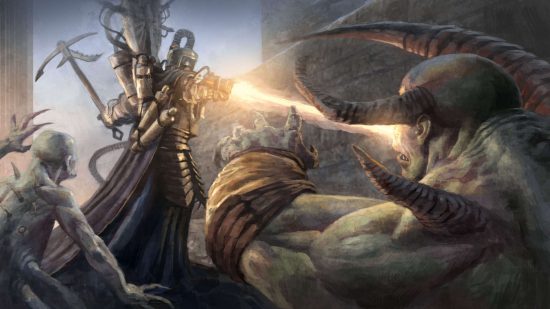
I found the Doom system to be forgettable; it’s rolled pre-battle but affects warband building, which didn’t stack up with how my opponent and I brought models for the game. You might find something else amiss in the rules – the campaign system doesn’t look that well tailored for more than two players, for example, but it could be easily adjusted.
The Doomed delivers on the central promise: it’s a skirmish warband game that gives you many excuses to get your weirdest kit bashes on the table. The central rules are light, but that slack is taken up by incredibly varied missions and blossoming options for warband customisation. Combat swings between inconclusive and utterly lethal, producing memorable, sometimes ridiculous turns of fate.
The book says to “Play to find out what happens”, and encourages you to make it your own. If you’re on board with that you’ll enjoy it. Like running an older model of car, this design isn’t locked down tight – you can take it apart and customise it just the way you want easily. But you will probably need to get your hands dirty now and again to keep it running.
In general complaints, the book needed another proof-reading pass. It would also benefit from colored side-bars to differentiate between sections: while it has two bookmarks, that’s not quite enough, and during games you’ll need to flick between a Horror, a Scenario, the core rules, and the Shock table.
In the interests of disclosure, I know McDowall personally, and as a result I’m not going to give the Doomed a score. It’s hell to think up an adequate score, anyway: the core audience for this game is people who see the rough edges of a rules set, or a miniature, as the starting point for their own creativity. This game has a kitbash attitude – if you do too, it’s probably right for you.
If you want to know more, check out our first preview of The Doomed, which has an interview with Chris McDowall. Our Into the Odd remastered review delves into another of his creations, an indie RPG. If you’re intrigued by Inq28 games but aren’t sure this one is right for you, have a look at Brawl Arcane 28, Necropolis28, and NonCombatTabletop for some more distinctive games from the scene.
